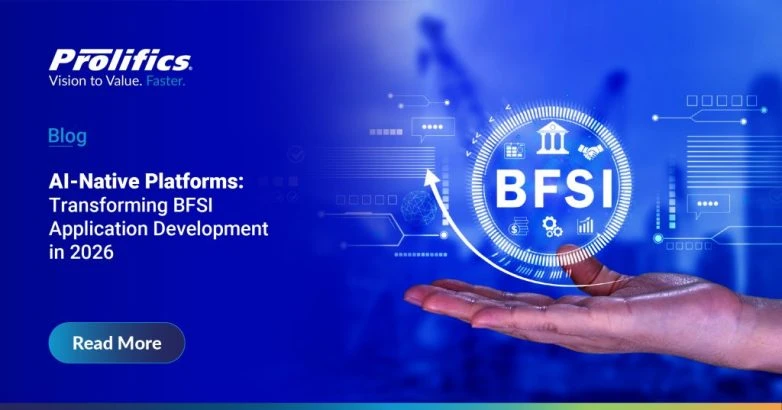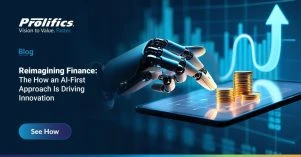The global Banking, Financial Services, and Insurance (BFSI) sector is entering a defining era of reinvention. After years spent modernizing legacy systems, scaling the cloud, and digitizing customer touchpoints, 2026 marks a pivotal shift from AI-Native Platforms in BFSI. Unlike traditional systems where AI is bolted on as a feature, AI-native platforms embed intelligence across the entire application stack, autonomously analyzing, predicting, optimizing, and acting in real time.
According to the IDC report titled, Unified AI & Agentic AI Platforms in Asia: Solution Insights for Technology Leaders , shows that, on average, only 23% of AI apps have gone from proof of concept (PoC) to production for Asia/Pacific. As AI capabilities evolve rapidly and more providers launch end-to-end platforms for AI-native application development, selecting the right AI platform requires a clear view of each vendor’s approach and how well the system aligns with current and future requirements.
This transformation goes far beyond efficiency gains. AI-native platforms are reshaping how banks build, run, and evolve applications; how insurers assess risk; how payment providers secure transactions; and how financial institutions deliver frictionless, hyper-personalized experiences. The BFSI organizations that embrace this shift will lead the industry. Those that do not risk irrelevance and will fall behind in how AI-native platforms are transforming banking and financial services.
The State of BFSI in 2026: Complex, Competitive, and Rapidly Evolving
The BFSI landscape is being reshaped by three powerful forces:

1. Rising Regulatory Demands
Compliance is no longer a static checklist. Frequent regulatory updates, complex audits, and the need for transparent AI decision-making require platforms that are explainable, adaptive, and traceable across every process — reinforcing the role of AI-powered regulatory compliance in BFSI.
2. Customer Expectations at an All-Time High
Consumers now expect:
- Real-time decisions
- Personalized financial products
- Autonomous servicing
- Zero waiting times
- High-trust digital interactions
AI-native systems meet these expectations through continuous learning and behaviour prediction supported by human-machine collaboration in financial services.
3. Competition from Neo-Banks and FinTechs
Digital competitors operate with agility, built on cloud, microservices, APIs, and automation. Traditional banks need AI-native systems to achieve similar operational velocity and compete with growing trends in agentic AI in banking.
Together, these dynamics set the stage for intelligent, autonomous BFSI operations powered by AI-native platforms and autonomous decision intelligence in banking.
Why AI-Native Platforms Matter in BFSI
AI-native systems do not just support business operations, they reimagine them. By embedding machine intelligence across data pipelines, workflows, decisions, and digital experiences, AI-native platforms deliver transformation across the full enterprise spectrum — positioning financial institutions to answer key questions like what is the difference between AI-enabled and AI-native platforms in BFSI?
1. Hyper-Personalization at Scale
AI-native platforms analyze millions of customer signals,transactions, behavior, sentiment, location, interactions, with real-time processing. This enables:
- Personalized product recommendations
- Context-aware financial wellness insights
- Intelligent credit decisioning
- Autonomous conversational servicing
A global bank, for instance, is already using advanced NLP and semantic search to deliver highly contextual wealth management insights, reducing advisor research time and improving customer outcomes.
2. Autonomous Back-Office Operations
The BFSI back office, once defined by manual processing, is now transforming through:
- Intelligent document classification
- Automated trade settlement
- Machine-led loan underwriting
- Smart claims adjudication
- Predictive risk scoring
A leading financial services provider leveraged machine learning to boost mortgage underwriting productivity, reducing time spent reviewing documents while increasing accuracy.
3. Precision-Driven Fraud Detection
Fraud patterns evolve quickly, and only AI can keep up.
AI-native fraud systems use:
- Multimodal data
- Anomaly detection
- Behavioral biometrics
- Transactional analytics
A global bank achieved major gains by using ML to detect fraud faster, reducing false positives while minimizing investigation time.
4. Regulatory Compliance That Runs Itself
AI-native compliance systems continuously analyze regulatory changes, monitor operations, and flag risks. They ensure:
- Automated KYC and AML
- Real-time suspicious activity detection
- Transparent audit trails
- Automated documentation and reporting
For compliance auditors, AI can increase audit volumes from 4–5 daily to 20+ by augmenting human analysis.
From AI-Enabled to AI-Native: What’s Changing in BFSI Development?
Traditional BFSI development follows a human-led model: data → rules → decisions.
AI-native shifts this to data → learning → autonomous optimization.
Key shifts include:
1. Autonomous Application Development
Agentic AI tools can generate code, test cases, APIs, data models, and integration scripts automatically. Developers become orchestrators, not coders.
2. Real-Time Human-Machine Interplay
AI-native platforms enable seamless switching between human and machine across BFSI operations:
- Machine-driven for high-volume repetitive tasks
- Machine-assisted for decision augmentation
- Human-driven for complex, empathy-required interactions
This dynamic interplay ensures the right balance of efficiency and human judgment.
3. End-to-End AI Decision Pipelines
Every workflow—payments, underwriting, onboarding, trade settlement—runs on self-optimizing AI models reconfigured based on performance and context.
4. Intelligent Integration Across Systems
API-led connectivity allows AI systems to tap into:
- Core banking
- Payment rails
- Policy administration systems
- Risk engines
- Cloud data lakes
This interconnected architecture allows AI to operate with full contextual awareness.
AI-Native Platforms in Action: Key BFSI Use Cases for 2026
Customer Servicing
- Virtual agents resolve most queries autonomously.
- Human agents get real-time insights for cross-sell and problem resolution.
- Context-aware routing ensures premium or distressed customers engage with humans instantly.
Fraud Mitigation
- Machine-driven anomaly detection scores every transaction
- Humans manage edge cases with rich AI insights
Trade Processing
- Straight-through processing becomes default
- AI predicts settlement failures, recommends actions
Recruitment and Workforce Management
- AI shortlists candidates, evaluates video interviews, assesses sentiment
- Human recruiters finalize high-complexity decisions
These use cases are already emerging, but by 2026, they will define BFSI operations.
Key Considerations for BFSI Firms on the AI-Native Journey
1. Adopt Enterprise-Wide AI Strategy
Isolated pilots do not drive transformation. BFSI leaders must define a unified AI vision across business lines, IT, compliance, and customer experience.
2. Ensure Trust and Explainability
Financial decisions require transparency. AI-native systems must:
- Explain decisions
- Provide audit-ready logs
- Manage bias
- Maintain regulatory alignment
3. Build Scalable Data Foundations
AI-native performance is only as strong as the data environment, data lakes, catalogs, lineage, governance, and real-time pipelines must be mature.
4. Manage Human-Machine Interplay
Organizations must define:
- Where machines take the lead
- Where human empathy is essential
- When dynamic switching is required
5. Prioritize Governance and Change Management
Leadership buy-in, governance models, and a culture that embraces AI are critical to successful long-term adoption.
Conclusion: How Prolifics Accelerates BFSI Transformation with AI-Native Platforms
As BFSI companies prepare for 2026, the shift to AI-native platforms will be the single most important technology investment of the decade. But success requires more than tools; it requires strategy, engineering, governance, and industry expertise.
This is where Prolifics stands apart.
With deep BFSI experience, advanced AI capabilities, and proven accelerators, Prolifics helps organizations transition from legacy and cloud-first models to intelligent, AI-native ecosystems.
Prolifics’ BFSI AI-Native Transformation Approach:
- AI-driven modernization of legacy banking, insurance, and financial applications.
- End-to-end implementation of agentic AI, GenAI, predictive analytics, and automation.
- Domain-rich models tailored for payments, onboarding, fraud, underwriting, KYC/AML, and claims.
- Enterprise-grade governance frameworks ensuring compliance, transparency, and security.
- Accelerators like ADAM, Integration Frameworks, and DataOps kits enabling faster deployment and reduced cost.
- Human-machine experience design that enhances customer engagement while maintaining regulatory trust.
Prolifics empowers BFSI organizations to reimagine every workflow, elevate customer experiences, and operate with unprecedented agility and intelligence.
In 2026 and beyond, AI-native BFSI platforms won’t just transform technology, they will transform the business itself. With Prolifics, the future of intelligent finance is already underway.
If you’re ready to begin your journey toward an AI-native future in banking, finance or insurance, we invite you to join us at the upcoming event:
Unlocking the Future of Banking & Finance with Agentic AI
📅 Date: December 4, 2025
📍 Location: IBM One Madison, 1 Madison Ave, New York, NY 10010
Hosted by Prolifics in collaboration with IBM. Prolifics
At this exclusive event you will:
- Discover real-world use-cases of agentic AI in banking and finance
- See how full-stack AI-native platforms drive operational efficiency, compliance and scale
- Connect with industry executives and experts shaping the future of BFSI
Reserve your seat today and join Prolifics in shaping the future of intelligent finance. Visit our Prolifics Events page for full details to register and take your first step toward transforming your organization with AI-native platforms.




